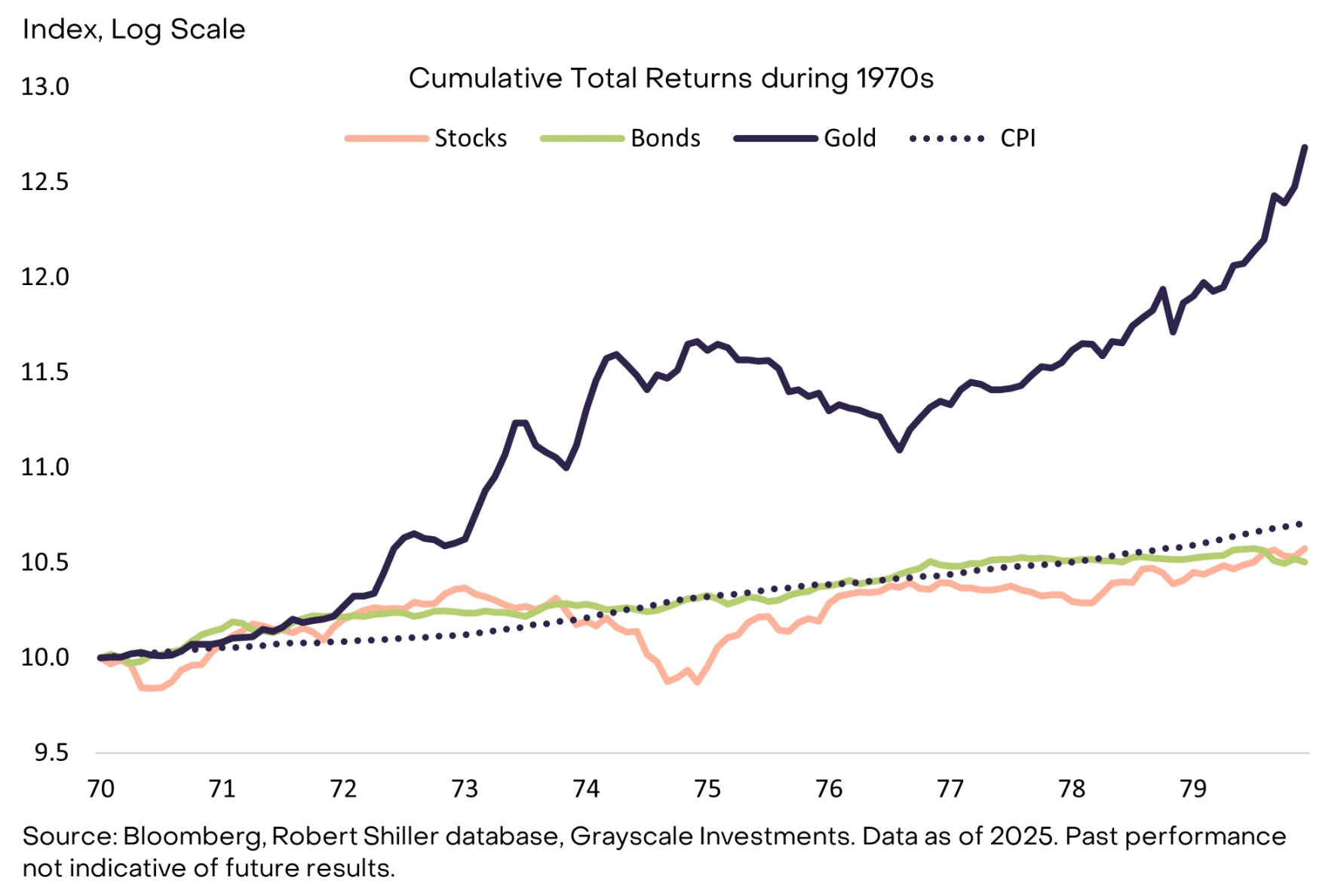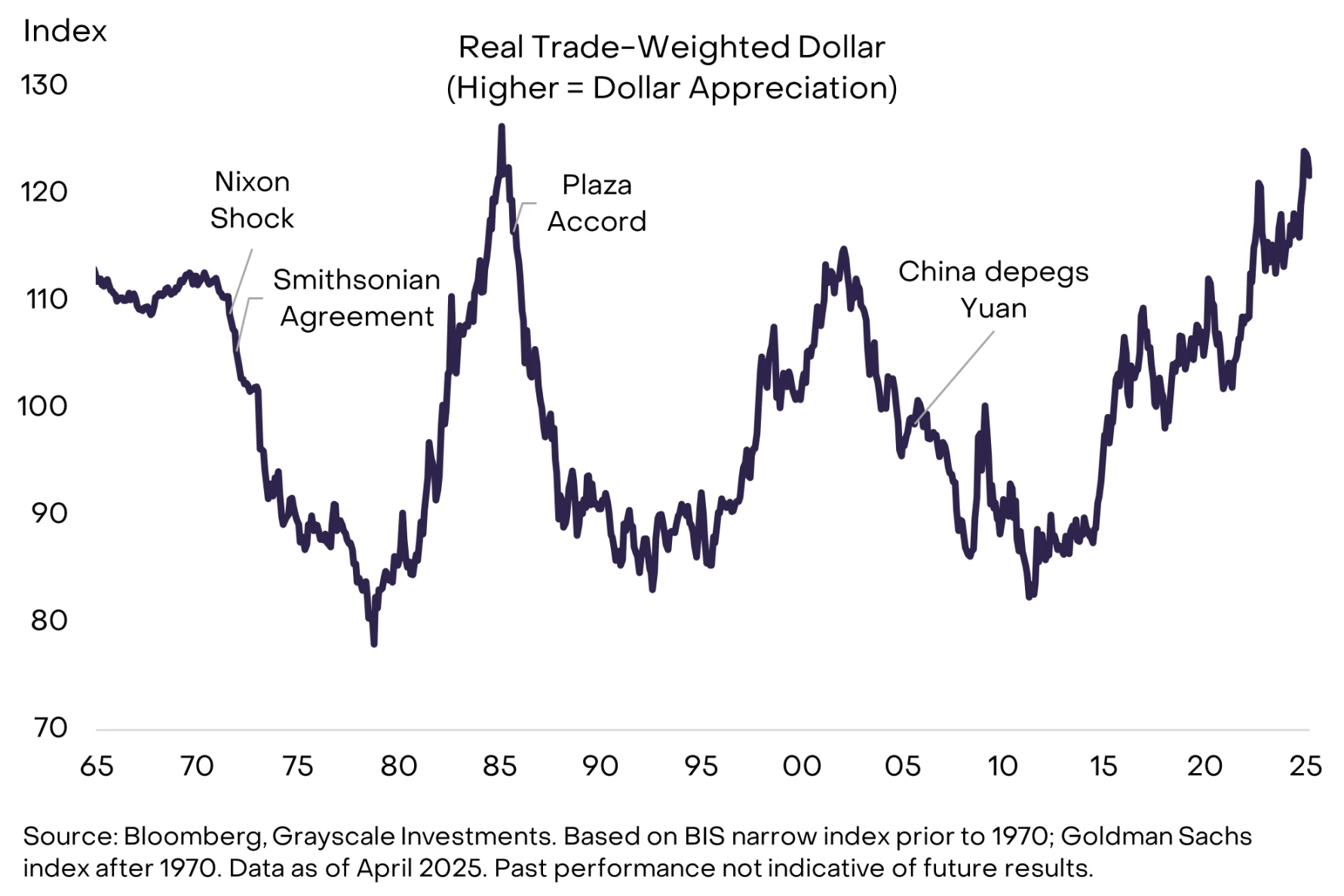Original Title: "Market Byte: Tariffs, Stagflation, and Bitcoin"
Written by: Zach Pandl
Translated by: Asher (@Asher_0210)
Editor's Note: This article analyzes the recent changes in the U.S. global tariff policy and its impact on financial markets, particularly the unique performance of Bitcoin during this process; it explores the long-term effects of tariffs on the economy, especially the choices of asset allocation during stagflation, and the performance of Bitcoin and gold in such an environment; it analyzes the current trade tensions' impact on the dollar and the potential adoption of Bitcoin, and finally provides an outlook on the economic prospects for the coming years, pointing out that Bitcoin and other scarce commodity assets like gold may receive more attention and demand in a high-inflation environment.

Since the U.S. announced its new global tariff policy on April 2, global asset prices have plummeted, only gradually recovering after Trump's announcement of a suspension of tariffs (except for China) this morning. However, the initial tariff announcement affected nearly all assets, and during this period, Bitcoin's decline was relatively small on a risk-adjusted basis. Therefore, if the correlation between Bitcoin and stock market returns is 1:1, the decline of the S&P 500 should imply a 36% drop in Bitcoin's price. However, the reality is that Bitcoin only fell by 10%, highlighting that even during deep market pullbacks, holding Bitcoin as part of a portfolio can still provide significant diversification benefits.

Bitcoin's price decline is relatively small on a risk-adjusted basis
In the short term, the outlook for global markets may depend on trade negotiations between the White House and other countries. While negotiations may lead to lower tariffs, setbacks in negotiations could trigger more retaliatory actions, and the actual volatility and implied volatility of traditional markets remain high, making it difficult to predict how trade conflicts will evolve in the coming weeks. Therefore, investors should cautiously adjust their positions in a high-risk market environment. Additionally, Bitcoin's price volatility has increased at a much lower rate than that of stocks, and several indicators show that speculative traders in the cryptocurrency market hold relatively low positions. If macro risks ease in the coming weeks, the market capitalization of cryptocurrencies is expected to rebound.

Implied volatility of stocks is close to that of Bitcoin
Regarding Bitcoin, despite its price decline over the past week, from a longer-term perspective, the impact of higher tariffs on Bitcoin will depend on their effects on the economy and international capital flows. Tariffs (and changes in related non-tariff trade barriers) may lead to "stagflation" and could result in structural weakness in dollar demand. Therefore, in this context, the increase in tariffs and changes in global trade patterns may be positive factors for Bitcoin adoption in the medium to long term.
Asset Allocation During Stagflation
Stagflation refers to an economic state characterized by slow or slowing economic growth, coupled with high or accelerating inflation rates. Tariffs have raised the prices of imported goods, which will lead to inflation rising (at least in the short term). At the same time, tariffs may also slow economic growth due to reduced real income for households and adjustment costs for businesses. In the long run, this impact may be partially offset by increased domestic manufacturing investment, and most economists expect these new tariffs to continue to weigh on the economy for at least the next year.
Historically, the asset returns of the 1970s vividly illustrate the impact of stagflation on financial markets (Bitcoin's existence is too short to backtest its performance). During that decade, the annualized returns of U.S. stocks and long-term bonds were both around 6%, below the average inflation rate of 7.4% at the time. In contrast, the price of gold rose at an annualized rate of about 30%, far exceeding the inflation rate.

Traditional assets had negative real returns in the 1970s
Typically, extreme cases of stagflation are rare, but their impact on asset returns has been generally consistent over time. The following chart shows the average annual returns of U.S. stocks, government bonds, and gold from 1900 to 2024 across different economic growth and inflation cycles.

Stagflation reduces stock returns and increases gold returns
Historical data reveals three key points:
- When GDP is high or accelerating and inflation is low or slowing, stock market returns tend to increase. Therefore, during stagflation, stock market returns are expected to decline, and investors may need to reduce equity allocations;
- When economic growth is sluggish and inflation rises, gold often performs well, especially during stagflation, where gold becomes a primary tool for hedging inflation. This indicates that in such an environment, gold is typically a more attractive investment choice;
- Bond performance is closely related to changes in inflation. When inflation is low, bond yields tend to be good, while when inflation rises, bond performance usually suffers. Therefore, during periods of rising inflation, bond investors may face the risk of declining returns.
- In summary, different assets perform differently throughout economic cycles, and investors should adjust their asset allocations based on the macroeconomic environment. This is particularly important during stagflation, as it often negatively impacts stocks while gold may see growth.
Bitcoin and the Dollar
Tariffs and trade tensions may drive the adoption of Bitcoin in the medium term, one reason being the pressure on dollar demand. Specifically, if overall trade flows with the U.S. decline, and most trade flows are denominated in dollars, the demand for dollar transactions will decrease. Additionally, if increased tariffs also lead to conflicts with other major countries, they may weaken the demand for the dollar as a store of value.
The dollar's share of global foreign exchange reserves far exceeds its share of global economic output. This situation exists for many reasons, but the network effect plays a significant role: countries trade with the U.S., borrow in the dollar market, and typically price commodities in dollars. If trade tensions weaken the ties to the U.S. economy and dollar-based financial markets, countries may accelerate the diversification of their foreign exchange reserves.

The dollar's share of global reserves far exceeds its share of the global economy
Many central banks have increased their gold purchases following Western sanctions against Russia. It is understood that, apart from Iran, no other country's central bank currently holds Bitcoin on its balance sheet. However, the Czech National Bank has begun exploring this option, the U.S. has established a strategic Bitcoin reserve, and some sovereign wealth funds have publicly announced investments in Bitcoin. In our view, disruptions to the dollar-centric international trade and financial system may lead central banks to further diversify their reserves, including investing in Bitcoin.
The moment in U.S. history most similar to President Trump's "Day of Liberation" declaration may be the "Nixon Shock" on August 15, 1971. That evening, President Nixon announced a comprehensive 10% tariff and ended the dollar's convertibility into gold—a system that had supported the global trade and financial system since the end of World War II. This action triggered diplomatic activities between the U.S. and other countries, ultimately leading to the Smithsonian Agreement in December 1971, where other countries agreed to revalue their currencies relative to the dollar. The dollar ultimately depreciated by 27% between the second quarter of 1971 and the third quarter of 1978. Over the past 50 years, there have been several rounds of trade tensions followed by (partially negotiated) dollar weakness.

Recent trade tensions are expected to lead to sustained dollar weakness again. According to relevant indicators, the U.S. dollar is already overvalued, the Federal Reserve has room to lower interest rates, and the White House aims to reduce the U.S. trade deficit. Although tariffs will change effective import and export prices, dollar depreciation may gradually achieve the desired effect of rebalancing trade flows through market mechanisms.
The Child of the Era—Bitcoin
The abrupt changes in U.S. trade policy are causing adjustments in financial markets, which will have short-term negative effects on the economy. However, the market conditions of the past week are unlikely to become the norm for the next four years. The Trump administration is implementing a series of policy measures that will have varying impacts on GDP growth, inflation, and the trade deficit. For example, while tariffs may reduce economic growth and increase inflation (i.e., causing stagflation), certain types of deregulation may boost growth and reduce inflation (i.e., alleviating stagflation). The ultimate outcome will depend on the extent to which the White House implements its policy agenda in these areas.

U.S. macroeconomic policy will have a series of impacts on growth and inflation
Despite the uncertainty in the outlook, the best guess is that U.S. government policies will lead to sustained dollar weakness and overall inflation above target in the next 1 to 3 years. Tariffs themselves may slow growth, but this impact may be partially offset by tax cuts, deregulation, and dollar depreciation. If the White House actively pursues other growth-promoting policies, GDP growth may remain relatively strong despite the initial shock from tariffs. Regardless of whether actual growth is robust, history shows that sustained inflationary pressures over a period may be beneficial for scarce commodities like Bitcoin and gold.
Moreover, like gold in the 1970s, Bitcoin now has a rapidly improving market structure—supported by changes in U.S. government policy. This year, the White House has implemented a series of broad policy changes that should support investment in the digital asset industry, including withdrawing a series of lawsuits, ensuring asset applicability to traditional commercial banks, and allowing regulated entities (such as custodians) to provide cryptocurrency services. This, in turn, has triggered a wave of mergers and acquisitions and other strategic investments. The new tariffs are a short-term disadvantage for the valuation of digital assets like Bitcoin, but the Trump administration's cryptocurrency-specific policies have consistently supported the industry. Overall, the rising macroeconomic demand for scarce commodity assets and the improved operating environment for investors may be a powerful combination for the widespread adoption of Bitcoin in the coming years.
免责声明:本文章仅代表作者个人观点,不代表本平台的立场和观点。本文章仅供信息分享,不构成对任何人的任何投资建议。用户与作者之间的任何争议,与本平台无关。如网页中刊载的文章或图片涉及侵权,请提供相关的权利证明和身份证明发送邮件到support@aicoin.com,本平台相关工作人员将会进行核查。




